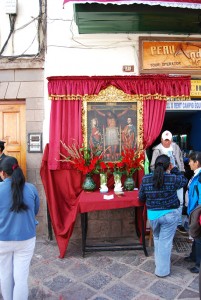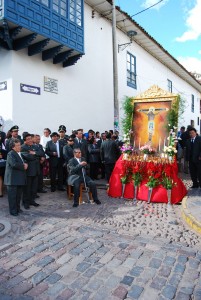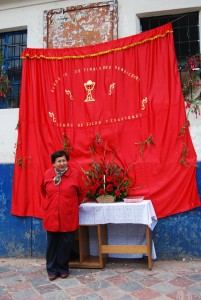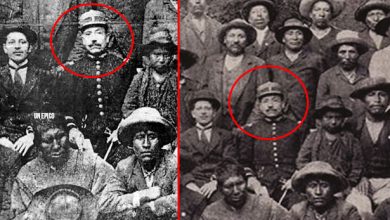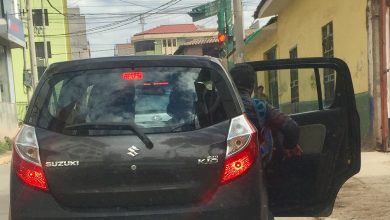The Lord of Temblor’s Story
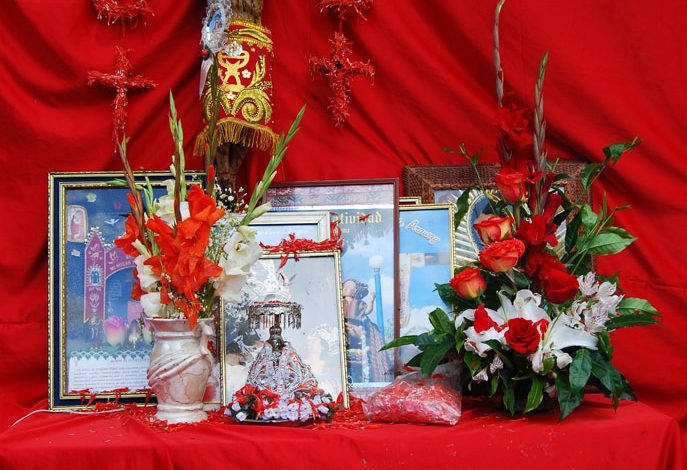
On Monday, an emaciated and blackened figure, looking for all the world like an Andean mummy nailed to a gold-encrusted cross, made its annual round through Cuzco in the midst of massive crowds of devotees. There is nothing more central to Cuzco’s life than this figure, the Lord of Temblors, and he has a story.
Here Cuzco Eats presents one version of this tale which was widely distributed in Cuzco during this year’s Holy Week under the byline of Emiliano Franco Cornejo and said to be based on the archives of the University of San Antonio Abad. (David Knowlton translated it.)
The photos that accompany this story show the altars that the various organizations of Cuzco set up to honor the Lord on his path.
Walter Coraza Morvelí took the photos.
King Phillip the II of Spain kept hearing that the Incas had worshiped the sun, as well as the Auquis and Apus (the old ones and the mountains.) During the feast of Inti Raymi, they said, the Incas would take out of their temples the mummies of the Inca monarchs and carry them through the city on gold and silver litters. They would sing melancholy melodies in Quechua as they went through the city of Cuzco.

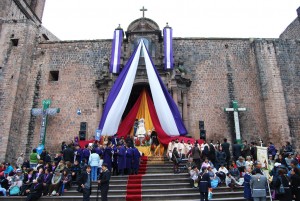
The King ordered those Inca customs be replaced with a procession of holy saints and virgens during Corpus Christi as a means of Christianizing the conquered people. This custom continues to this day.
At that time, the King’s Viceroy Francisco de Toledo ordered the people of Cuzco to put crosses on the hills around the city where they used to worship other huacas, sacred places and beings.
The King had sculpted in Seville, Spain a figure of Christ of natural human size with features and color that suggested the inhabitants of the Inca people, it is said. Once completed, the body of Christ was packed carefully in a good box, so it could be shipped by sea to the Peruvian port of Callao.
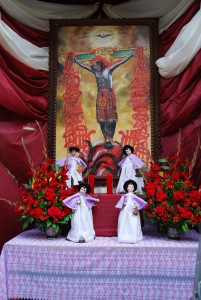
The religious shipment was accompanied by other ships that carried European goods, such as wines, oils, food, medicines, clothing, among other things. Along with the Christ on the sea voyage came various friars and missionaries, politicans, treasurersm as well as the wives of the voyagers. They also brought their black slaves to serve them.
The ships sailed under the guidance of seasoned sailors during the long trip that lasted months. The flotilla was menaced with strong winds, great waves, thunder and lightning, and people were told to pray and take confession under the threat of immediate death.
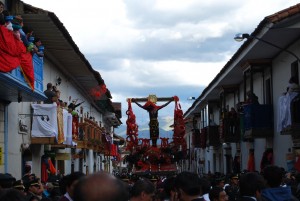
The main passenger was a new bishop for the arch diocese of Cuzco. During the storm he remembered they were bringing the Christ given by the King of Spain. He begged the sea captain to bring out the box with the cross. Thy tied the hoy figure to the main mast of the lead ship. After reciting prayers they sailors and passengers begged the figure to cause the storm to cease.
After a few brief moments the hurricane like winds stopped and the thunder and lightning ceased. That night they saw a sky filled with stars and they returned the Jesus to his box for the rest of the journey.
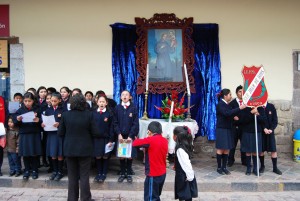
From the port of Callao the Christ and his companions continued on to the city of Cuzco carried by mules from the distant city of Tucuman [now part of Argentina] and under the care of many Indians and black slaves.
Once the Christ had arrived at Cuzco’s Plaza de Armas, it caused great admiration among the populace. With the sounding of bells and the placing of flowers on the body of the holy image it was placed in a chapel within the Cathedral.
Many years passed and one Thursday, at two in the afternoon on the 31st of March in 1650, an earthquake struck Cuzco. It destroyed houses, temples, and roads as well as causing landslides. A red dust filled the city and crazed its population.
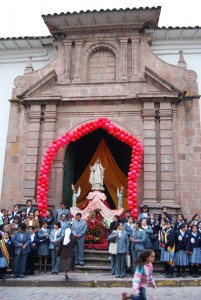
The Cathedral’s canons thought to take the figure of Christ into the streets on their shoulders and walk around the main square, the Plaza de Armas or Waukaypata. The Lord’s devotees called out all the priests from the cities churches and monasteries–Santo Domingo, San Agustin, La Merced, and the Jesuits of La Compañía de Jesús. They came out barefoot, begging forgivenness for any sins, incense flowing into their faces and whipping their backs with scourges. The Franciscan friars also came out and amazed the city’s populace with their acts of penitence; they carried very heavy crosses and wore crowns of thorns while crying out for forgivenness.
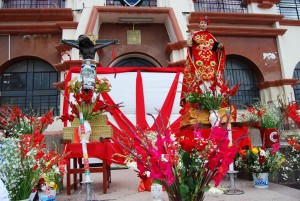
At another time, another earthquake struck Cuzco. Some three hundred years after the first one, at 2:45 pm, an afternoon of full sunshine, on the 21st of May, 1950, the city was struck with a deafening shaking which in a few seconds converted much of the city to rubble. More than one hundred people died and their were many wounded. Electric cables were on the ground along with their fallen posts. It took place just when Cuzco’s fans were on their way to the University Stadium for a game with the Sport Boys from Callao and Lima.
In the aftershocks, after dark, the Lord of Earthquakes was brought out of the Cathedral’s doors, surrounded by people in the midst of scenes of suffering and repentance. People begged forgiviennes from the brown-skinned Christ because the month before, in April, on the Monday of Holy Week they had not taken the Lord from the Cathedral in procession because the city of Cuzco was covered with a heavy snow fall. The streets were impassable from 30-40 centimeters of snow.
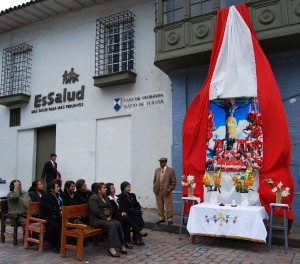
The city found itself in darkness with no water or communication to the outside. At the time the only broadcaster was Radio Cuzco which could not function due to the quake. Nevertheless, a radio hobbiest was able to let Lima know about the earthquake, since the outside world had not known. The first emergency help came from Argentina’s president Juan Domingo Perón. His wife, Eva Perón, personally brought the aid of tents, blankets, medicines, clothing, and canned goods, among other things.
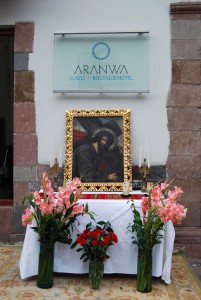
A whole series of things has happend ever since the Christ arrived in Cuzco from Spain.
[Translater’s note. This tale, which locates the Christ in the midst of history and a telling few of its important figures is one version of many. Instead of emphasizing the miracles of the Christ in calming the earthquakes, it hints at them through its asociation with powerful figures. The Christ becomes more of a companion during difficult history than a problem solver, as other versions emphasize. In addition, according to other versions gathered by anthropologist Abraham Valencia the figure paused before coming to Cuzco in Mollepata where the figure was captured and a replacement, locally produced statue sent on to Cuzco as if it were the original image.]